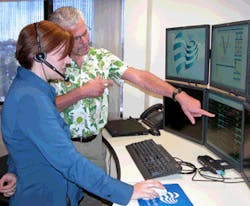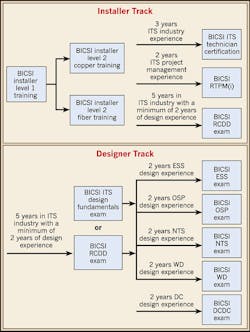Electrical Contractors and Division 27 & 28 Certifications
Hidden deep within your next project’s specifications may be a certification requirement that someone in your company or one of your subcontractors must attain. These certifications come from a variety of organizations and companies. Owners and designers add them to their project specifications as a quality assurance
The design and installation of advanced security or audio/video systems may require additional training and certifications directly from a manufacturer.
measure. Informed contractors pay special attention to these requirements, making sure they meet them prior to bid. An uninformed contractor, on the other hand, may have to scramble to meet the specification requirements right before construction begins.
The Construction Specifications Institute’s (CSI) MasterFormat standard breaks out specifications for building projects in the United States and Canada into 40 divisions, which is organized by work results (materials and methods). Division 27 covers Communications Systems, and Division 28 covers Electronic Safety and Security Systems. Within Division 27, the following systems can be found, all of which come with different certifications that owners or designers might require:
- Telecommunications infrastructure — the physical, non-active (non-powered) components, such as the copper and fiber cabling, which make up the telecommunications system as well as the equipment racks and pathways, such as ladder rack, cable trays, and conduit. (Yes, communications conduit has its own Division 27 specification section.)
- Network equipment — the active (powered) components that include routers, switches, servers, wireless, and other IT equipment.
- Audio/video (AV) infrastructure and equipment — permanently installed AV cabling and outlets and powered AV electronic equipment at both ends.
Telecommunications Infrastructure
For the telecommunications infrastructure, the most prevalent vendor-neutral certifications are offered by BICSI International. Specifically, for the telecommunications system (i.e., the copper and fiber cabling), BICSI offers installer certifications: the general Installer Level 1 as well as the more advanced Installer Level 2 Copper and Installer Level 2 Fiber. These certifications are available directly through BICSI (or an authorized training facility) and simply require completion of the approved training program.
For example, University of Texas at Austin construction standards require all workers installing any part of the telecommunicationssystems at the university to have a BICSI Level 1 Certified Installer credential (at minimum) and be supervised by an appropriate Level 2 Certified Installer. Alternatively, the University would consider similar training certificates from a telecommunications system manufacturer if that manufacturer’s equipment was being used on the project.
Beyond the installer certification requirements on a project, there is another common requirement the telecommunications designer and contractor might encounter. The Registered Communications Distribution Designer (RCDD) designation is awarded to those individuals who have demonstrated knowledge in the design, implementation, and integration of information technology systems and related infrastructure. To qualify to sit for the RCDD exam, BICSI requires at least five years of direct design experience — or two years, if the individual has three years of educational or installation experience (for a total of five years). Most of the time, the building owner drives the requirement for workers to have the RCDD credential.
For installation, it is common to see either the owner or RCDD require that the installing telecommunications contractor also have an RCDD on its staff. This is mainly for construction oversight to ensure that a fully qualified individual is aware of the installation project and ensures everything is installed to BICSI’s Telecommunications Distribution Methods Manual (TDMM). Because the installation contractor has this same design certification, it is not uncommon to see owners require them to stamp the record or as-built drawings with their RCDD stamp at the completion of the project.
Even if not directly called out, the project specifications may also silently require the installation contractor to have an RCDD on staff. Many manufacturers offer advanced system warranties of 15 to 20 years, which the owner or designer may require. In order to offer this type of warranty, the installer needs to be a certified contractor with that manufacturer. (Note: Some, but not all, of these manufacturers require an RCDD on staff in order for a company to become certified.) Either way, it’s worth checking the specifications closely for an RCDD and/or an advanced system warranty requirement.
If any portion of the telecommunications project falls outside the building envelope, then another certification might come into play — the Outside Plant (OSP) designation, which is awarded to individuals who have demonstrated knowledge in OSP right-of-way and route design; space design (maintenance holes, ducts, vaults); underground, direct-buried, and aerial plant design; cabling hardware; and grounding, bonding, and electrical protection systems. To qualify to sit for the OSP exam, BICSI requires two years of verifiable OSP design and either having already passed the RCDD exam or ITS Design Fundamentals exam. This last prerequisite offers someone wanting an OSP designation a way to attain it without first having to have five years of experience and pass the RCDD exam.
Network Equipment
Even though it is more common to see owners design, purchase, install, and manage their own active network equipment, some owners may not have the resources to do so. Therefore, they decide to include this type of work in a construction project. In this case, the following BICSI certifications could come into play:
- Network Technology Systems (NTS) designer
- Wireless Designer (WD)
- Data Center Design Consultant (DCDC)
Although geared more toward the planning and design portion of the project, don’t be surprised if an owner requires the installer/contractor to have one or more of these certifications. The NTS and WD exams are each based on their own reference manual, whereas the DCDC exam encompasses questions derived from three different BICSI publications. In addition, to be eligible for the NTS and WD exams, you need two years of experience and either a current RCDD status or proof of passing the ITS Fundamentals exam. To qualify for the DCDC exam, you must have two years of verifiable experience.
If an owner has decided on a specific vendor for his or her network and wireless systems, he or she might require training or certification from that vendor for the project. For example, Cisco offers its own Cisco Certified Network Associate (CCNA) designation, and Microsoft has many certifications and tracks to indicate proficiency with its systems.
Audio/video systems
For audio/video system design and installation, the most common certifications are offered through InfoComm International via its basic certification, known as the Certified Technology Specialist (CTS). There appears to be no formal experience prerequisites or an all-encompassing design manual to review; however, InfoComm offers various resources on its website (such as the CTS Handbook) to use as a study guide.
For designers, InfoComm offers the CTS-Design (CTS-D) certification. To be eligible to take the exam, you must already hold the CTS certification and have two years of verifiable AV design experience. Again, there doesn’t appear to be a definitive publication where all test questions are derived, but the organization’s website lists a couple of primary references and other resources.
For installers, InfoComm offers the CTS-Installation (CTS-I) certification. This too, requires a current CTS certification and two years of experience. It also offers various online and print publications for use as a study guide as well as classroom courses.
Besides certifications through InfoComm, advanced AV systems necessitating a control system may necessitate specific certifications be obtained from certain manufacturers, each of which offers its own design, installation, and programming certifications.
Security Systems
On the security front, ASIS International offers three certifications that test knowledge in specific security applications. The Certified Protection Professional (CPP) indicates board certification in security management, and is widely recognized as the highest designation accorded a security practitioner. Two specialty certifications are also available: the Professional Certified Investigator (PCI) and the Physical Security Professional (PSP).
To be eligible for the CPP exam, you must have three or more years of “responsible charge” — making independent decisions and actions in regard to security systems — with either nine total years of security experience or a bachelor’s degree and seven years of experience. To be eligible for the PCI exam, you must have two years of experience in case management and either five years of investigation experience or a high school diploma (or equivalent). The PSP designation is perhaps the most practical to require for design or installation. To be eligible for this exam, you must either have four years of progressive security experience with either a bachelor’s degree or six years of experience without one.
As technology has advanced, security components and systems are converging onto the building’s telecommunications infrastructure and data network. The biggest example is the dramatic shift away from CCTV video security systems with DVRs to IP (Internet protocol) cameras with a Network Video Recorder (NVR). As such, those installing Division 28 systems may start seeing telecommunications system requirements, such as BICSI’s RCDD, become part of the security specifications.
Recognizing the convergence of security and IT systems, BICSI now offers an Electronic Safety and Security (ESS) design certification. This exam is eligible to those with two years of verifiable electronic safety and security system design who have previously passed the RCDD or ITS Fundamentals exam. It is based inclusively on its Electronic Safety and Security Design Reference Manual.
Overview
Although the certifications outlined in this article are by no means a complete list of all of those available in the market, they are the most widely known and accepted today. They are also the certifications typically referenced by owners and designers in the specifications or required by manufacturers in order to offer advanced 15+-year warranties. So before you bid on that next project, read the specifications carefully to ensure you don’t overlook one of these key requirements.
Peterworth works in the Information Technology Services – Networking & Telecommunications department at the University of Texas at Austin. He can be reached at: [email protected].





